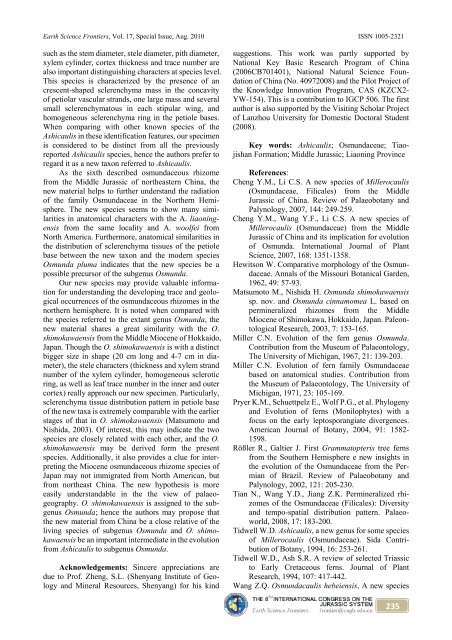in Jurassic and Cretaceous Stratigraphy
in Jurassic and Cretaceous Stratigraphy
in Jurassic and Cretaceous Stratigraphy
You also want an ePaper? Increase the reach of your titles
YUMPU automatically turns print PDFs into web optimized ePapers that Google loves.
Earth Science Frontiers, Vol. 17, Special Issue, Aug. 2010 ISSN 1005-2321<br />
such as the stem diameter, stele diameter, pith diameter,<br />
xylem cyl<strong>in</strong>der, cortex thickness <strong>and</strong> trace number are<br />
also important dist<strong>in</strong>guish<strong>in</strong>g characters at species level.<br />
This species is characterized by the presence of an<br />
crescent-shaped sclerenchyma mass <strong>in</strong> the concavity<br />
of petiolar vascular str<strong>and</strong>s, one large mass <strong>and</strong> several<br />
small sclerenchymatous <strong>in</strong> each stipular w<strong>in</strong>g, <strong>and</strong><br />
homogeneous sclerenchyma r<strong>in</strong>g <strong>in</strong> the petiole bases.<br />
When compar<strong>in</strong>g with other known species of the<br />
Ashicaulis <strong>in</strong> these identification features, our specimen<br />
is considered to be dist<strong>in</strong>ct from all the previously<br />
reported Ashicaulis species, hence the authors prefer to<br />
regard it as a new taxon referred to Ashicaulis.<br />
As the sixth described osmundaceous rhizome<br />
from the Middle <strong>Jurassic</strong> of northeastern Ch<strong>in</strong>a, the<br />
new material helps to further underst<strong>and</strong> the radiation<br />
of the family Osmundaceae <strong>in</strong> the Northern Hemi-<br />
sphere. The new species seems to show many simi-<br />
larities <strong>in</strong> anatomical characters with the A. liaon<strong>in</strong>g-<br />
ensis from the same locality <strong>and</strong> A. woolfei from<br />
North America. Furthermore, anatomical similarities <strong>in</strong><br />
the distribution of sclerenchyma tissues of the petiole<br />
base between the new taxon <strong>and</strong> the modern species<br />
Osmunda pluma <strong>in</strong>dicates that the new species be a<br />
possible precursor of the subgenus Osmunda.<br />
Our new species may provide valuable <strong>in</strong>forma-<br />
tion for underst<strong>and</strong><strong>in</strong>g the develop<strong>in</strong>g trace <strong>and</strong> geolo-<br />
gical occurrences of the osmundaceous rhizomes <strong>in</strong> the<br />
northern hemisphere. It is noted when compared with<br />
the species referred to the extant genus Osmunda, the<br />
new material shares a great similarity with the O.<br />
shimokawaensis from the Middle Miocene of Hokkaido,<br />
Japan. Though the O. shimokawaensis is with a dist<strong>in</strong>ct<br />
bigger size <strong>in</strong> shape (20 cm long <strong>and</strong> 4-7 cm <strong>in</strong> dia-<br />
meter), the stele characters (thickness <strong>and</strong> xylem str<strong>and</strong><br />
number of the xylem cyl<strong>in</strong>der, homogeneous sclerotic<br />
r<strong>in</strong>g, as well as leaf trace number <strong>in</strong> the <strong>in</strong>ner <strong>and</strong> outer<br />
cortex) really approach our new specimen. Particularly,<br />
sclerenchyma tissue distribution pattern <strong>in</strong> petiole base<br />
of the new taxa is extremely comparable with the earlier<br />
stages of that <strong>in</strong> O. shimokawaensis (Matsumoto <strong>and</strong><br />
Nishida, 2003). Of <strong>in</strong>terest, this may <strong>in</strong>dicate the two<br />
species are closely related with each other, <strong>and</strong> the O.<br />
shimokawaensis may be derived form the present<br />
species. Additionally, it also provides a clue for <strong>in</strong>ter-<br />
pret<strong>in</strong>g the Miocene osmundaceous rhizome species of<br />
Japan may not immigrated from North American, but<br />
from northeast Ch<strong>in</strong>a. The new hypothesis is more<br />
easily underst<strong>and</strong>able <strong>in</strong> the the view of palaeo-<br />
geography. O. shimokawaensis is assigned to the sub-<br />
genus Osmunda; hence the authors may propose that<br />
the new material from Ch<strong>in</strong>a be a close relative of the<br />
liv<strong>in</strong>g species of subgenus Osmunda <strong>and</strong> O. shimo-<br />
kawaensis be an important <strong>in</strong>termediate <strong>in</strong> the evolution<br />
from Ashicaulis to subgenus Osmunda.<br />
Acknowledgements: S<strong>in</strong>cere appreciations are<br />
due to Prof. Zheng, S.L. (Shenyang Institute of Geo-<br />
logy <strong>and</strong> M<strong>in</strong>eral Resources, Shenyang) for his k<strong>in</strong>d<br />
suggestions. This work was partly supported by<br />
National Key Basic Research Program of Ch<strong>in</strong>a<br />
(2006CB701401), National Natural Science Foun-<br />
dation of Ch<strong>in</strong>a (No. 40972008) <strong>and</strong> the Pilot Project of<br />
the Knowledge Innovation Program, CAS (KZCX2-<br />
YW-154). This is a contribution to IGCP 506. The first<br />
author is also supported by the Visit<strong>in</strong>g Scholar Project<br />
of Lanzhou University for Domestic Doctoral Student<br />
(2008).<br />
Key words: Ashicaulis; Osmundaceae; Tiao-<br />
jishan Formation; Middle <strong>Jurassic</strong>; Liaon<strong>in</strong>g Prov<strong>in</strong>ce<br />
References:<br />
Cheng Y.M., Li C.S. A new species of Millerocaulis<br />
(Osmundaceae, Filicales) from the Middle<br />
<strong>Jurassic</strong> of Ch<strong>in</strong>a. Review of Palaeobotany <strong>and</strong><br />
Palynology, 2007, 144: 249-259.<br />
Cheng Y.M., Wang Y.F., Li C.S. A new species of<br />
Millerocaulis (Osmundaceae) from the Middle<br />
<strong>Jurassic</strong> of Ch<strong>in</strong>a <strong>and</strong> its implication for evolution<br />
of Osmunda. International Journal of Plant<br />
Science, 2007, 168: 1351-1358.<br />
Hewitson W. Comparative morphology of the Osmun-<br />
daceae. Annals of the Missouri Botanical Garden,<br />
1962, 49: 57-93.<br />
Matsumoto M., Nishida H. Osmunda shimokawaensis<br />
sp. nov. <strong>and</strong> Osmunda c<strong>in</strong>namomea L. based on<br />
perm<strong>in</strong>eralized rhizomes from the Middle<br />
Miocene of Shimokawa, Hokkaido, Japan. Paleon-<br />
tological Research, 2003, 7: 153-165.<br />
Miller C.N. Evolution of the fern genus Osmunda.<br />
Contribution from the Museum of Palaeontology,<br />
The University of Michigan, 1967, 21: 139-203.<br />
Miller C.N. Evolution of fern family Osmundaceae<br />
based on anatomical studies. Contribution from<br />
the Museum of Palaeontology, The University of<br />
Michigan, 1971, 23: 105-169.<br />
Pryer K.M., Schuettpelz E., Wolf P.G., et al. Phylogeny<br />
<strong>and</strong> Evolution of ferns (Monilophytes) with a<br />
focus on the early leptosporangiate divergences.<br />
American Journal of Botany, 2004, 91: 1582-<br />
1598.<br />
Rößler R., Galtier J. First Grammatopteris tree ferns<br />
from the Southern Hemisphere e new <strong>in</strong>sights <strong>in</strong><br />
the evolution of the Osmundaceae from the Per-<br />
mian of Brazil. Review of Palaeobotany <strong>and</strong><br />
Palynology, 2002, 121: 205-230.<br />
Tian N., Wang Y.D., Jiang Z.K. Perm<strong>in</strong>eralized rhi-<br />
zomes of the Osmundaceae (Filicales): Diversity<br />
<strong>and</strong> tempo-spatial distribution pattern. Palaeo-<br />
world, 2008, 17: 183-200.<br />
Tidwell W.D. Ashicaulis, a new genus for some species<br />
of Millerocaulis (Osmundaceae). Sida Contri-<br />
bution of Botany, 1994, 16: 253-261.<br />
Tidwell W.D., Ash S.R. A review of selected Triassic<br />
to Early <strong>Cretaceous</strong> ferns. Journal of Plant<br />
Research, 1994, 107: 417-442.<br />
Wang Z.Q. Osmundacaulis hebeiensis, A new species<br />
235

















